Abstract
Ureaplasma diversum is a pathogen in the bovine reproductive tract. The objective of the research was to study interactions with macrophages and lymphocytes which might elucidate aspects of pathogenetic mechanisms of this organism. We studied the activation of murine macrophages of C3H/HeN (LPS-responder) and C3H/HeJ (LPS-low-responder) genotype for TNF-alpha, IL-6, IL-1 and nitric oxide production and blastogenic response of C3H/HeJ splenocytes after Ureaplasma diversum stimulation. Live and heat-killed U. diversum induced TNF-alpha, IL-6 and IL-1 in peritoneal macrophage cultures of both C3H/HeN and C3H/HeJ mice in a dose dependent manner. Interferon-gamma modulated the cytokine production, by increasing the production of TNF-alpha, IL-6 and nitric oxide, but IL-1 secretion was only enhanced in C3H/HeJ macrophages stimulated by live ureaplasmas. Supernatant of U. diversum sonicate was mitogenic for murine spleen lymphocytes. The blastogenic response was dose dependent, and stimulation with both U. diversum and Concanavalin A seemed to have an additive effect. These results suggest that U. diversum, similar to other mycoplasmas, activates murine macrophages and lymphoid cells. The studies should be repeated with bovine cells in order to elucidate pathogenetic aspects of inflammation in cattle caused by U. diversum.
Full text
PDF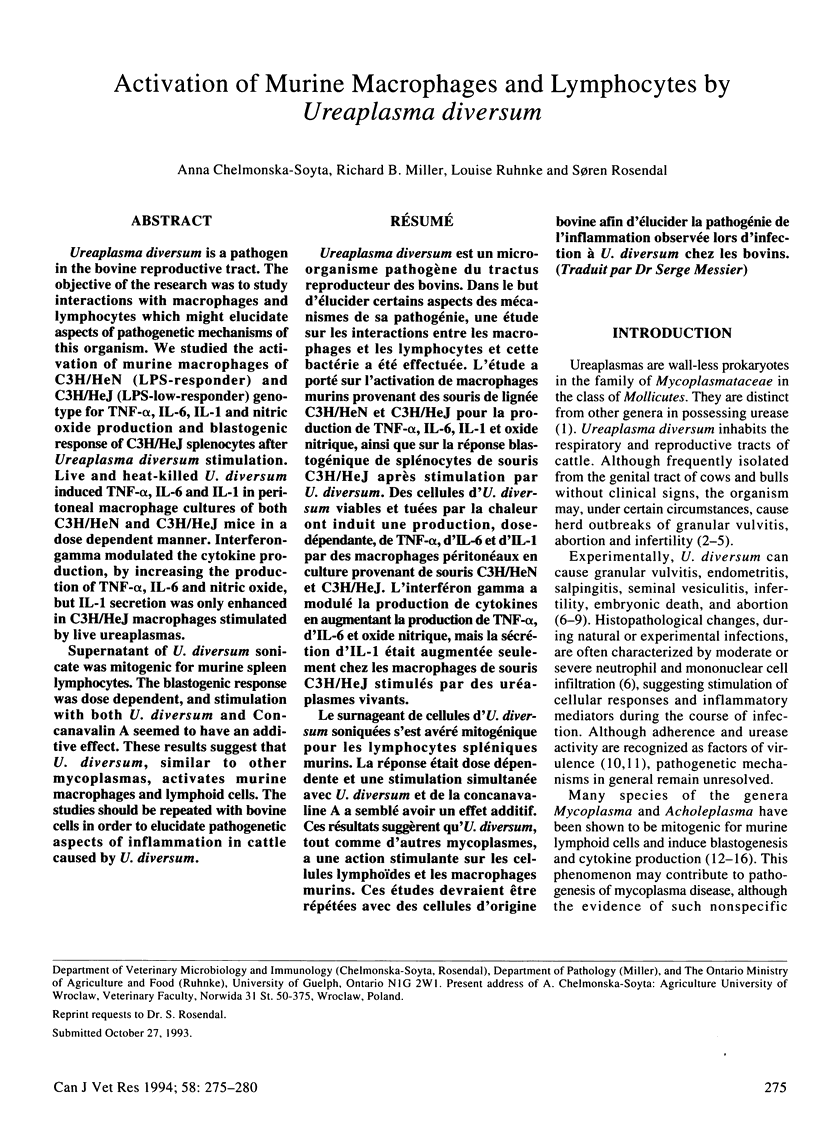
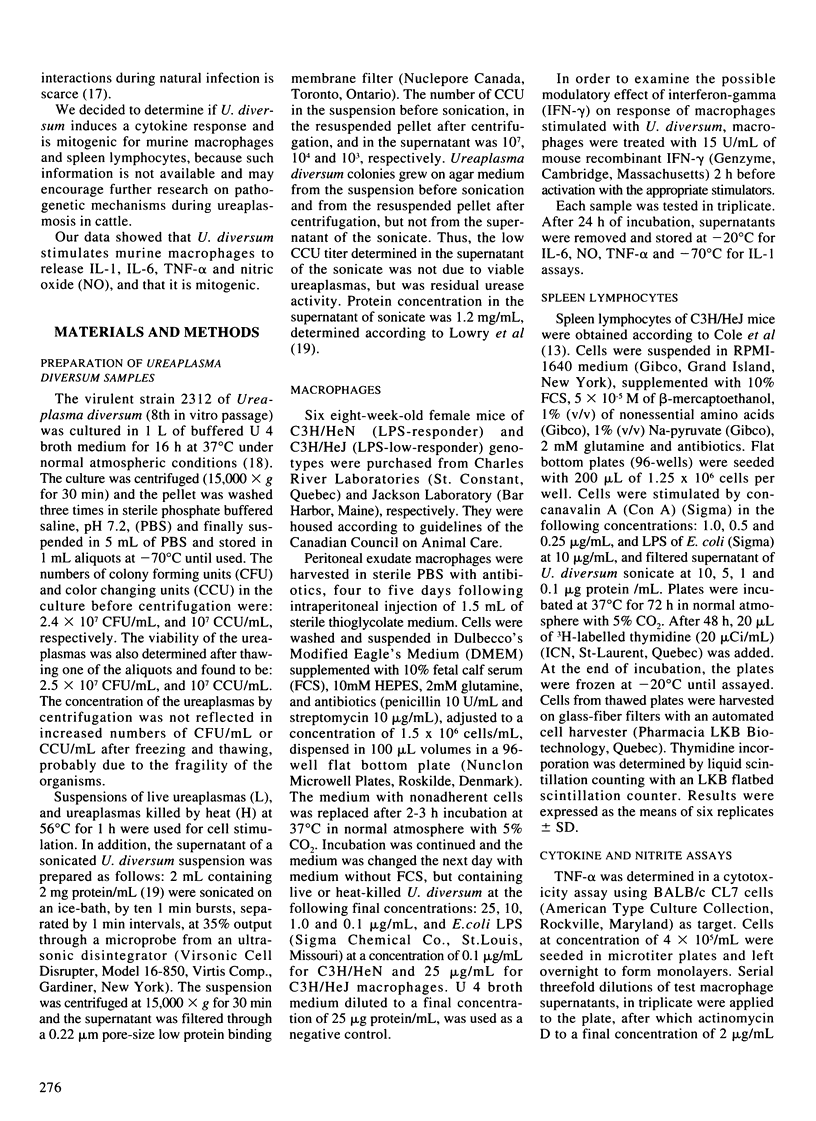
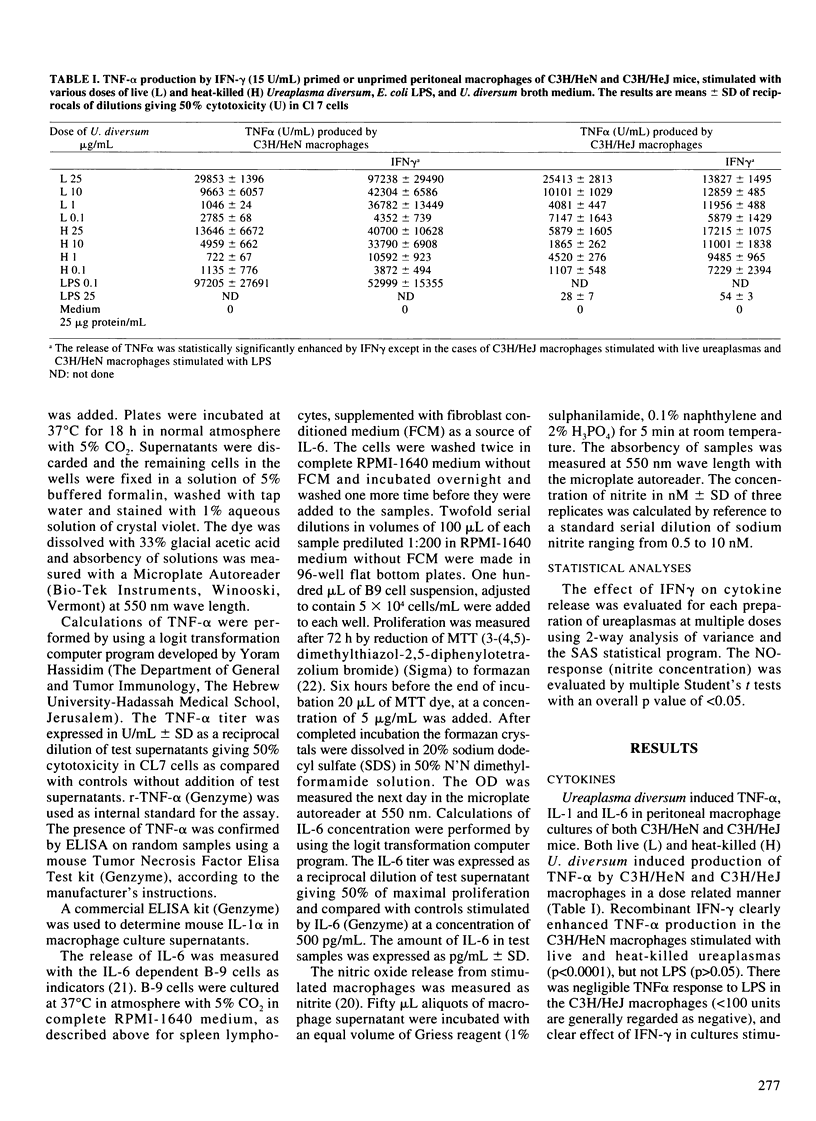

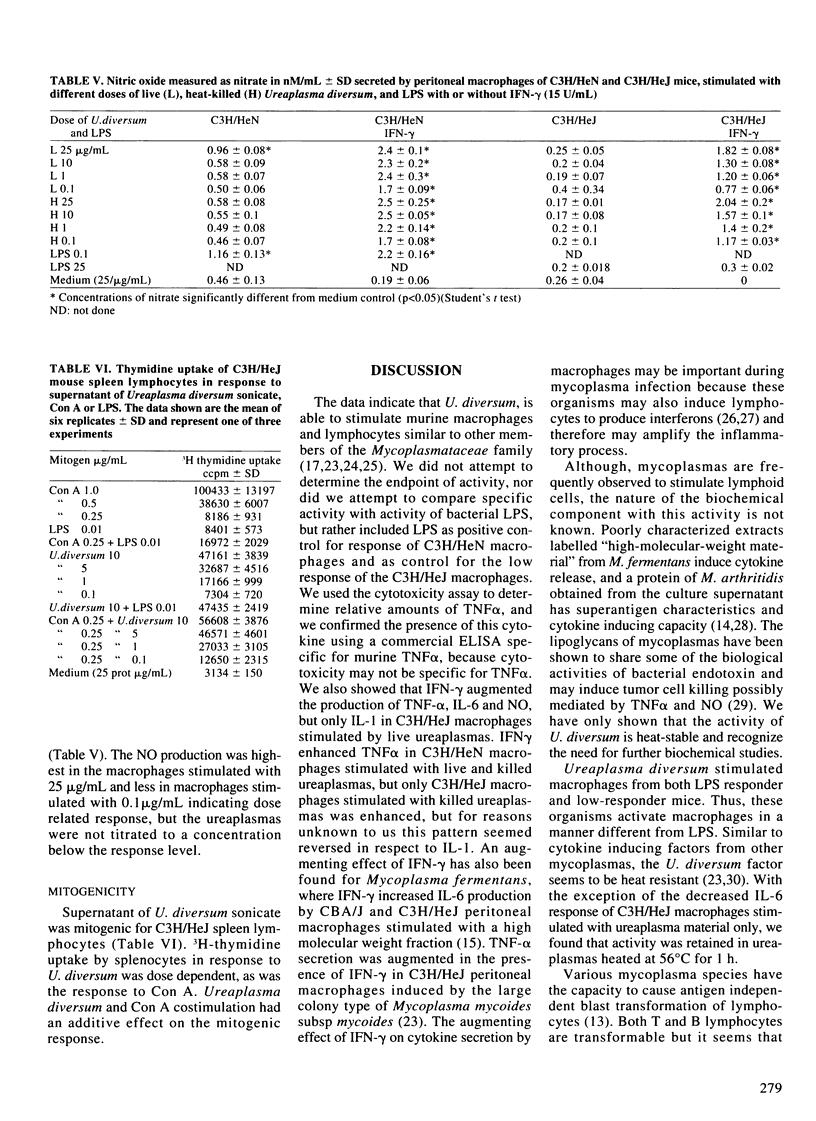
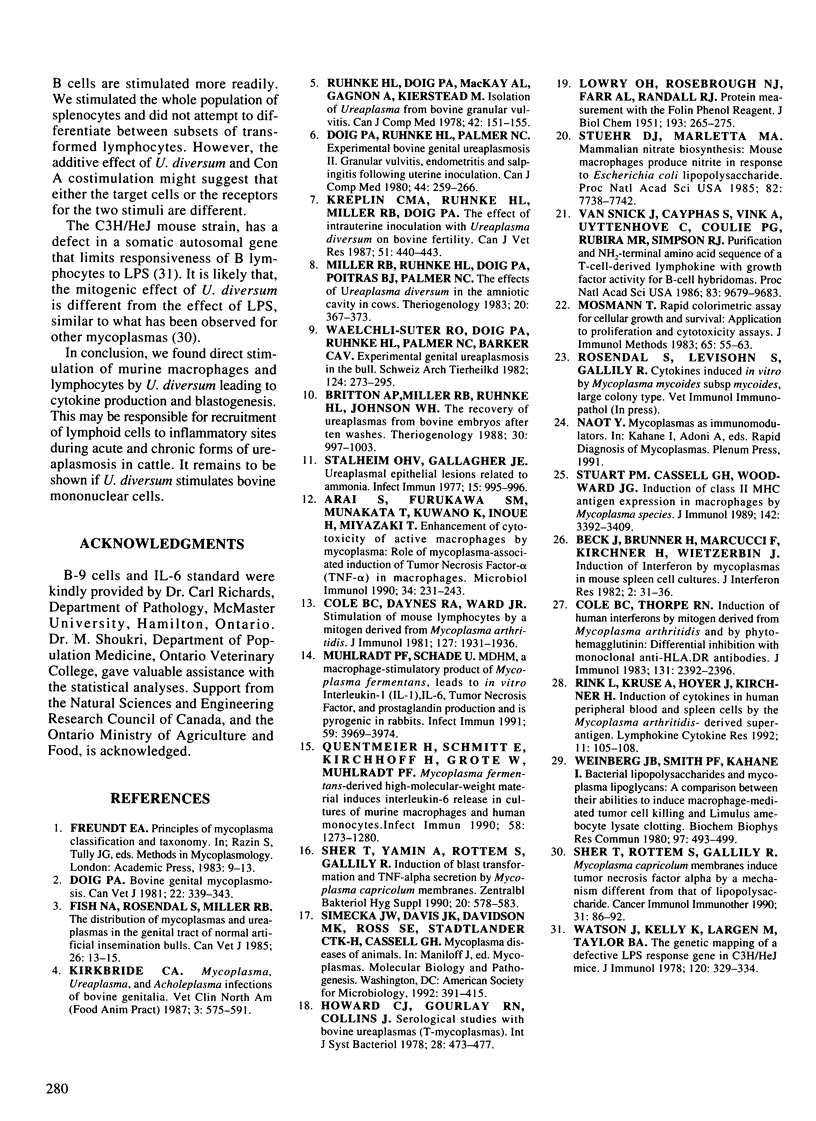
Selected References
These references are in PubMed. This may not be the complete list of references from this article.
- Arai S., Furukawa M., Munakata T., Kuwano K., Inoue H., Miyazaki T. Enhancement of cytotoxicity of active macrophages by mycoplasma: role of mycoplasma-associated induction of tumor necrosis factor-alpha (TNF-alpha) in macrophages. Microbiol Immunol. 1990;34(3):231–243. doi: 10.1111/j.1348-0421.1990.tb01006.x. [DOI] [PubMed] [Google Scholar]
- Beck J., Brunner H., Marcucci F., Kirchner H., Wietzerbin J. Induction of interferon by mycoplasmas in mouse spleen cell cultures. J Interferon Res. 1982;2(1):31–36. doi: 10.1089/jir.1982.2.31. [DOI] [PubMed] [Google Scholar]
- Britton A. P., Miller R. B., Ruhnke H. L., Johnson W. H. The recovery of ureaplasmas from bovine embryos following in vitro exposure and ten washes. Theriogenology. 1988;30(5):997–1003. doi: 10.1016/s0093-691x(88)80062-1. [DOI] [PubMed] [Google Scholar]
- Cole B. C., Daynes R. A., Ward J. R. Stimulation of mouse lymphocytes by a mitogen derived from Mycoplasma arthritidis. I. Transformation is associated with an H-2-linked gene that maps to the I-E/I-C subregion. J Immunol. 1981 Nov;127(5):1931–1936. [PubMed] [Google Scholar]
- Cole B. C., Thorpe R. N. Induction of human gamma interferons by a mitogen derived form Mycoplasma arthritidis and by Phytohemagglutinin: differential inhibition with monoclonal anti-HLA.DR antibodies. J Immunol. 1983 Nov;131(5):2392–2396. [PubMed] [Google Scholar]
- Doig P. A. Bovine genital mycoplasmosis. Can Vet J. 1981 Nov;22(11):339–343. [PMC free article] [PubMed] [Google Scholar]
- Doig P. A., Ruhnke H. L., Palmer N. C. Experimental bovine genital ureaplasmosis. II. Granular vulvitis, endometritis and salpingitis following uterine inoculation. Can J Comp Med. 1980 Jul;44(3):259–266. [PMC free article] [PubMed] [Google Scholar]
- Fish N. A., Rosendal S., Miller R. B. The distribution of mycoplasmas and ureaplasmas in the genital tract of normal artificial insemination bulls. Can Vet J. 1985 Jan;26(1):13–15. [PMC free article] [PubMed] [Google Scholar]
- Kirkbride C. A. Mycoplasma, Ureaplasma, and Acholeplasma infections of bovine genitalia. Vet Clin North Am Food Anim Pract. 1987 Nov;3(3):575–591. doi: 10.1016/s0749-0720(15)31131-2. [DOI] [PubMed] [Google Scholar]
- Kreplin C. M., Ruhnke H. L., Miller R. B., Doig P. A. The effect of intrauterine inoculation with Ureaplasma diversum on bovine fertility. Can J Vet Res. 1987 Oct;51(4):440–443. [PMC free article] [PubMed] [Google Scholar]
- LOWRY O. H., ROSEBROUGH N. J., FARR A. L., RANDALL R. J. Protein measurement with the Folin phenol reagent. J Biol Chem. 1951 Nov;193(1):265–275. [PubMed] [Google Scholar]
- Miller R. B., Ruhnke H. L., Doig P. A., Poitras B. J., Palmer N. C. The effects of Ureplasma diversum inoculated into the amniotic cavity in cows. Theriogenology. 1983 Sep;20(3):367–374. doi: 10.1016/0093-691x(83)90071-7. [DOI] [PubMed] [Google Scholar]
- Mosmann T. Rapid colorimetric assay for cellular growth and survival: application to proliferation and cytotoxicity assays. J Immunol Methods. 1983 Dec 16;65(1-2):55–63. doi: 10.1016/0022-1759(83)90303-4. [DOI] [PubMed] [Google Scholar]
- Mühlradt P. F., Schade U. MDHM, a macrophage-stimulatory product of Mycoplasma fermentans, leads to in vitro interleukin-1 (IL-1), IL-6, tumor necrosis factor, and prostaglandin production and is pyrogenic in rabbits. Infect Immun. 1991 Nov;59(11):3969–3974. doi: 10.1128/iai.59.11.3969-3974.1991. [DOI] [PMC free article] [PubMed] [Google Scholar]
- Quentmeier H., Schmitt E., Kirchhoff H., Grote W., Mühlradt P. F. Mycoplasma fermentans-derived high-molecular-weight material induces interleukin-6 release in cultures of murine macrophages and human monocytes. Infect Immun. 1990 May;58(5):1273–1280. doi: 10.1128/iai.58.5.1273-1280.1990. [DOI] [PMC free article] [PubMed] [Google Scholar]
- Rink L., Kruse A., Nicklas W., Hoyer J., Kirchner H. Induction of cytokines in human peripheral blood and spleen cells by the Mycoplasma arthritidis-derived superantigen. Lymphokine Cytokine Res. 1992 Apr;11(2):105–108. [PubMed] [Google Scholar]
- Ruco L. P., Meltzer M. S. Defective tumoricidal capacity of macrophages from C3H/HeJ mice. J Immunol. 1978 Jan;120(1):329–334. [PubMed] [Google Scholar]
- Ruhnke H. L., Doig P. A., MacKay A. L., Gagnon A., Kierstead M. Isolation of Ureaplasma from bovine granular vulvitis. Can J Comp Med. 1978 Apr;42(2):151–155. [PMC free article] [PubMed] [Google Scholar]
- Sher T., Rottem S., Gallily R. Mycoplasma capricolum membranes induce tumor necrosis factor alpha by a mechanism different from that of lipopolysaccharide. Cancer Immunol Immunother. 1990;31(2):86–92. doi: 10.1007/BF01742371. [DOI] [PMC free article] [PubMed] [Google Scholar]
- Stalheim O. H., Gallagher J. E. Ureaplasmal epithelial lesions related to ammonia. Infect Immun. 1977 Mar;15(3):995–996. doi: 10.1128/iai.15.3.995-996.1977. [DOI] [PMC free article] [PubMed] [Google Scholar]
- Stuart P. M., Cassell G. H., Woodward J. G. Induction of class II MHC antigen expression in macrophages by Mycoplasma species. J Immunol. 1989 May 15;142(10):3392–3399. [PubMed] [Google Scholar]
- Stuehr D. J., Marletta M. A. Mammalian nitrate biosynthesis: mouse macrophages produce nitrite and nitrate in response to Escherichia coli lipopolysaccharide. Proc Natl Acad Sci U S A. 1985 Nov;82(22):7738–7742. doi: 10.1073/pnas.82.22.7738. [DOI] [PMC free article] [PubMed] [Google Scholar]
- Van Snick J., Cayphas S., Vink A., Uyttenhove C., Coulie P. G., Rubira M. R., Simpson R. J. Purification and NH2-terminal amino acid sequence of a T-cell-derived lymphokine with growth factor activity for B-cell hybridomas. Proc Natl Acad Sci U S A. 1986 Dec;83(24):9679–9683. doi: 10.1073/pnas.83.24.9679. [DOI] [PMC free article] [PubMed] [Google Scholar]
- Waelchli-Suter R. O., Doig P. A., Ruhnke H. L., Palmer N. C., Barker C. A. Experimental genital ureaplasmosis in the bull. Schweiz Arch Tierheilkd. 1982 Jun;124(6):273–295. [PubMed] [Google Scholar]
- Weinberg J. B., Smith P. F., Kahane I. Bacterial lipopolysaccharides and mycoplasmal lipoglycans: a comparison between their abilities to induce macrophage-mediated tumor cell killing and Limulus amebocyte lysate clotting. Biochem Biophys Res Commun. 1980 Nov 28;97(2):493–499. doi: 10.1016/0006-291x(80)90290-9. [DOI] [PubMed] [Google Scholar]


